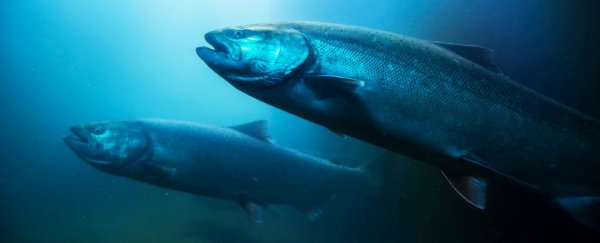The ability to detect our planet's magnetic field and use it as a map while migrating, homing or hunting could well be one of the most remarkable feats of evolution, and it's also one of the most mysterious.
While this powerful sense is well established in many animal species, including birds, bats, rodents and fish, we still don't actually know how these creatures pull it off.
New insights into Chinook salmon (Oncorhynchus tshawytscha) have now reinforced the hypothesis that the juvenile fish of this species use microscopic magnetoreceptors embedded in their tissue to navigate via Earth's magnetic field.
At least, they seem to do so when they're in the ocean. Once they hit the freshwater stream, researchers at Oregon State University (OSU) think they might switch over to a different chemical-based system.
"To our knowledge, these results are the first to demonstrate that a magnetic pulse affects orientation behaviour in fish," the authors claim.
When it's time to spawn, Chinook salmon are famous for being able to find their way back to the exact stream where they were hatched, and there are currently two reigning theories as to why that is.
It could be that these fish sense Earth's magnetic field through chemical reactions induced by magnetism, or it could be that they sense it through the presence of a magnetoreceptor in the animal itself. It may also be a mixture of both.
The problem is, primary magnetoreceptors are notoriously difficult to find. They're really small, can be sparse and located nearly anywhere within the body of an animal, so gathering definitive evidence on them is extremely challenging.
All we can really do right now is 'pulse' the animals with a magnetic field and see if they respond.
In the OSU study, researchers looked at what happens to juvenile salmons subject to magnetic pulses compared to those who were subject to none.
Two different environments were used, one which mimicked a local magnetic field and another that mimicked a distant ocean location in the Chinook salmon range.
In the former local scenario, the authors found pulsed and un-pulsed fish behaved almost identically. But in the larger, global scenario, pulsed fish did not show random orientation like the others. Instead, their heads pointed in a similar direction to one another.
"Interestingly, salmon are known to possess both a magnetic 'compass' that enables them to use Earth's magnetic field as a directional cue and a magnetic 'map' that allows them, in effect, to assess their position within an ocean basin," the study authors explain.
"In principle, the mechanism underlying the compass, the map, or both might have been affected by the magnetic pulse."
In this case, the authors think this underlying compass has something to do with crystals of magnetite, which have been implicated in the same group of fish in the past.
"Our findings are consistent with the hypothesis that magnetoreceptors are based on magnetite crystals," says OSU fisheries and wildlife biologist David Noakes, although he still admits more research will be needed to verify this hypothesis and reveal its true mechanisms.
"We're trying to figure out the life cycle of the salmon from the points of highest information - when they go from fresh water to salt water and when they turn around and come back."
If the results are right, Chinook salmon now belong on a growing list of taxa affected by magnetic pulses; but what does that actually tell us? Despite growing evidence, primary magnetoreceptors have not been unambiguously identified in any animal as of yet.
While magnetic pulses have previously been demonstrated to affect orientation behaviour in a variety of terrestrial and aquatic animals, including rodents, bats, birds, sea turtles, and lobsters, the results are mixed and unclear.
As such, the authors argue their findings among Chinook salmon are consistent with the magnetite hypothesis.
"In the big picture, these salmon know where they are, where they're supposed to be, how to get there and how to make corrections if needed," says Noakes.
"While they're in freshwater, they're imprinting upon the chemical nature of the water. When they hit salt water, they switch over to geomagnetic cues and lock in that latitude and longitude, knowing they need to come back to those coordinates."
The study was published in The Journal of Experimental Biology.
